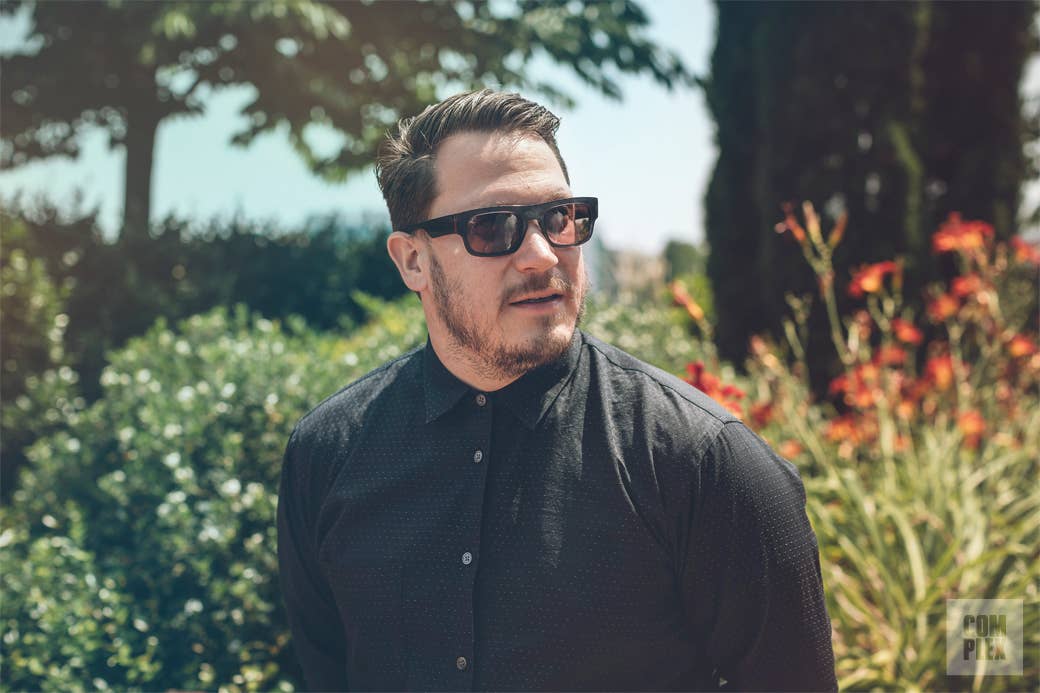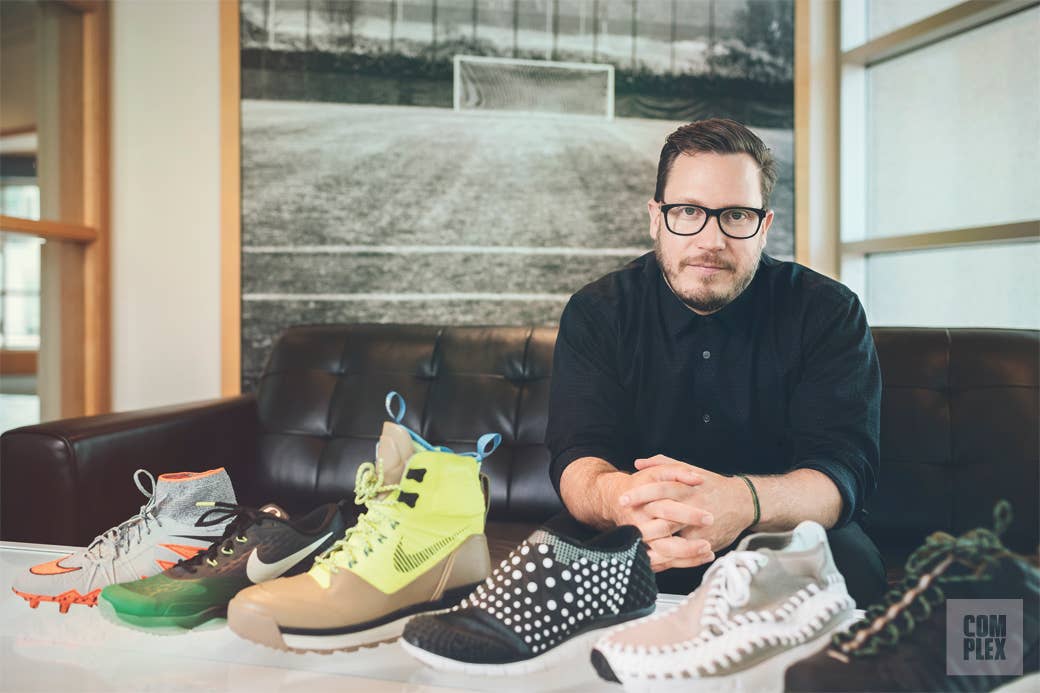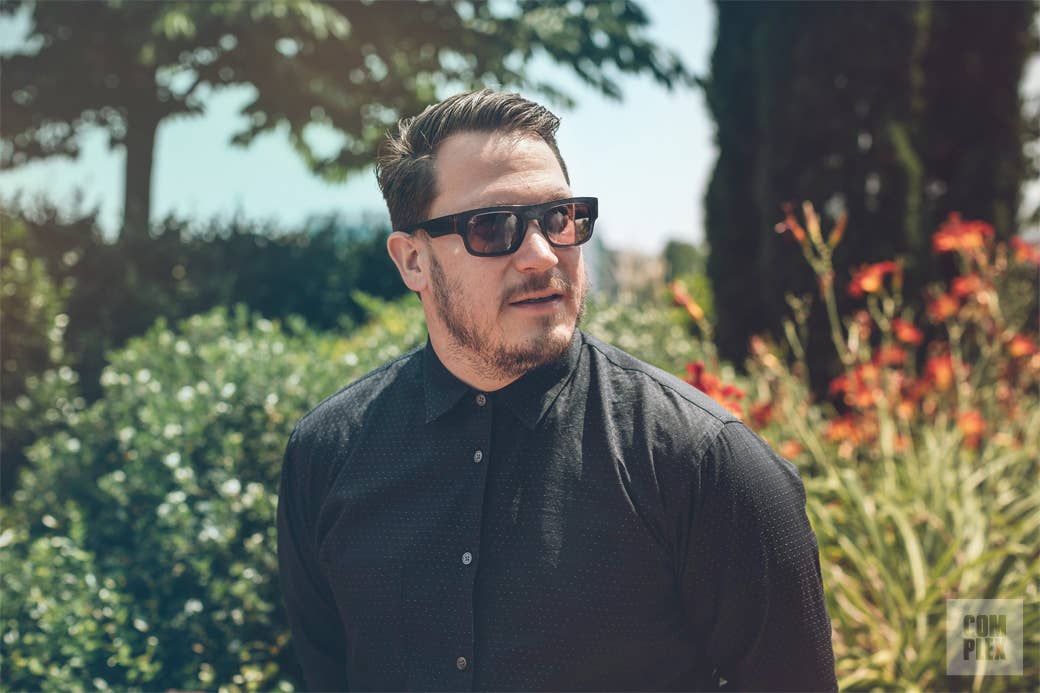
In 1987, Nike released the Air Max 1, a shoe dreamt up by an unknown designer with a non-traditional background: Tinker Hatfield. Perhaps you’ve heard of him? Hatfield’s designs—referencing everything from avant-garde architecture to fighter jets—revolutionized sneakers. Now Nike has another young designer with a varied résumé who’s looking to leave a similarly outsized footprint. With over half a dozen sneakers under his belt (including hits like the Air Yeezy 2, Mayfly Woven, and the Air Footscape Magista), Nathan VanHook is quietly building his own legacy at Beaverton.
Born and raised just outside of Washington, D.C., VanHook, now 34, worked as a middle school teacher in inner-city Philadelphia and as a wetsuit designer before joining the Swoosh in 2008. (He’s also an accomplished painter.) His time at Nike has included stints in the cross-training and sportswear departments, with his most famous silhouettes reflecting his wide-ranging interests, as seen in the goth-inspired raised geometric diamonds on the Free Orbit 2 SP and the rustic retro-futurism of the Solarsoft Moccasin. He’s now the design director for Nike’s burgeoning soccer department. With three of Nike’s elite designers having abruptly defected to rival adidas late last year, VanHook’s role at the company is more important than ever as he sets himself up to carry Tinker’s torch. But where will that road lead? How will he get there? Let Nate tell you.
This feature originally appears in Complex's October/November issue.

How did your previous work at Nike lead to your current position as the design director of football?
I came into Nike in 2008 with a background in art and design. I did a bunch of gallery shows in Los Angeles and I also worked as a design director designing wetsuits. Those two things put together offered something different that Nike was looking for. [At first] I designed shoes for boutiques and shoes that helped drive some buzz for Nike Sportswear. I did that for about two and a half years and then I went to ACG [All Conditions Gear].
I worked in the ACG division for two years, then Men’s Training for about a year and a half, and then this opportunity came up to be in Global Football. I’ve had a bunch of different opportunities at Nike, and the benefit of having a lot of sportswear experience is being able to bring the innovations from running and basketball [design] to people’s everyday lives. Football is really a blend of both of those. It’s the highest-performing product with unique problems and unique solutions.
What’s the most challenging category you’ve worked in?
I don’t think any of them are that challenging. It’s how you want to shape the vision and what kind of opportunities there are. The great thing about going to places with opportunities—and that’s why Men’s Training was interesting—is that it’s not what it is, it’s what it could be. Global Football, which has such amazing energy right now, has all these resources and a dream team of designers from all over the world to help push this to another revolution, another level. Everything’s an opportunity, but what’s your spin on it?
Nike has experimented with turning football silhouettes into cool lifestyle sneakers—the latest being the Footscape Magista. Is that something that consumers can expect to see more of in the future?
Yeah. With anything, if it looks good and if the team can twist it in the right way and provide people with a new feel, then sure.

You touched on the fact that you’re an artist. How has your art played a role in your design work at Nike?
I think art is interesting because it’s about the process—especially the artwork I do. It opens you up to different things and different ways of making and looking at depth. Everybody at Nike who’s a designer is creative and all my close friends do all sorts of different things. The more creative outlets you have, the more you push yourself and the more experiences you gain.
Speaking of diverse interests, you used to design wetsuits and teach middle school. How did those experiences impact your work at Nike?
I did a bunch of teacher assistant stuff with different high schools in inner-city Philadelphia. I really like the idea of giving back and helping the youth, and an art-and-design teaching gig came up. Looking back on it, I was a 22-year-old dealing with 140 13-year-olds, so trying to connect with kids on a personal level, and also trying to captivate them and get their attention, that’s where I learned a lot. It helped me lead various teams [at Nike] and also helped me be a better father.
Designing wetsuits was all about range in motion. You’re literally creating a second skin, and it’s super high-performance, too, because if you don’t have a wetsuit on you can’t surf. It was about pattern engineering around the body and really designing for motion but also materiality—which is the great thing about footwear. It blends that apparel background of uppers and a sculptural, historic product-design sense in the midsoles, and also tooling, which is the bottoms of shoes. It’s been a really amazing blend of all my interests.

What’s the most significant sneaker design that you’ve worked on?
My best work is going to be coming out in the future because every shoe you work on builds on the next. Of my shoes to date, I’d say the Lunarterra Arktos, because it was built for such a hardcore climate.
The Lunarterra Arktos melds performance and lifestyle. What was the inspiration behind it?
That was inspired by going to New York City during a blizzard. I actually got to go to Moscow and it’s very similar to New York— it snows from December all the way to April, so you’re walking through slush. The idea was to create something that was going to keep your foot dry and warm. They were mainly modeled after matryoshka dolls, the stacking Russian dolls. It was having a sock inside a boot—the sock was your lining, and the boot was just the outer layer that kept your foot dry.

Training sneakers weren’t originally intended to be lifestyle shoes. What’s the greatest challenge in making them cool?
The very first shoes I begged my parents for were the SC Trainer in the Bo Jackson colorway and the Trainer 1. When going into Men’s Training, we were able to sit down and talk to Tinker Hatfield about how Nike invented Training. At one point it was massive, second only to Basketball. It had such a rich history. So the idea was to tap into that when I came back to Training: creating shoes that are super wearable but also perform at the highest level. Training takes shoes and breaks them down to the minimal need and that was the big push for our design team. I worked on the Hypercross where the technology came from the LeBron [sneaker line] and Women’s Training. The teams had great success with products that came out after that, like the Metcon 1 and the Nike Free shoes; it really is a blend of being wearable and high-performance. It’s something you can go to the gym in and walk on the street in as well.
"I love the idea that people don’t know what they want until you show it to them. That’s really what we do as designers at Nike. We’re working in the future."
If you could only wear one Nike sneaker for the rest of your life what would it be?
The Presto by far. I was in high school or college when it came out, but I remember all the different colors, patterns, how easy it is to put on, and how simple it is. I still love that shoe and I think that was one of the very first kinds of performance/lifestyle crossover shoes produced. I loved the marketing campaign too. It was like a T-shirt for your feet with small, medium, and large sizes. It was great then and it’s great now.
How did designing Kanye West’s second signature sneaker, the Air Yeezy 2, change your career?
The Yeezy 2 was trying to push what Nike could bring to the table and create something super iconic, and it was a great product to work on. But that project was in 2010; it was five years ago. It was a great shoe, but I feel like I’ve had a lot of other great projects as well.

Do you feel like that’s what a lot of people know you for?
I actually try to keep a low profile about my design work and projects like that. People might associate my name with that shoe and that’s something I’m proud of. It was a great product and a lot of people loved it, but I think people just associate me with being a designer at Nike. My friends don’t even see me as a designer, just somebody who’s good to hang out with and a fun guy, so however people want to perceive things, it’s all positive.
You work with a lot of different athletes. What does that kind of collaborative process entail?
Whether it’s collaborations or [working with] athletes, all I’m looking for from them is insight or what benefit that they’re trying to get. I love the idea that people don’t know what they want until you show it to them. That’s really what we do as designers at Nike. That’s why I love working at Nike. We’re working in the future right now, we’re shaping everybody’s future, and that’s why I’m always looking farther ahead.
Is there a specific sneaker or design that exemplifies that ethos?
The football boots that came out last year during the World Cup. There had never been a boot that was a sock or that went above your ankle, but the players actually loved it. I remember being a kid and seeing the new Jordans coming out. When you first looked at them they were so crazy and you’re like, “Wow.” Then you see them more and more and you start to love them. It’s amazing to be able to do that, and I think we did that for the boots and the Nike Free. Every project I work on, I want to have that sensation of, “Wow, what is that?”


